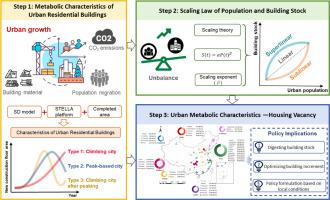中国城市住宅存量系统规模与空置住宅碳排放核算
IF 10.9
1区 环境科学与生态学
Q1 ENGINEERING, ENVIRONMENTAL
引用次数: 0
摘要
城市住房空置是一个重要而敏感的研究课题,尤其对中国的发展而言。然而,住宅存量增长机制与住房空置率之间的复杂关系尚不清楚。利用综合系统动力学模型和尺度理论,建立了对城市住宅存量增长的最新认识,并探讨了空置住宅的碳排放。研究发现,单个城市人口与住宅存量增长具有普遍的标度规律,大多数城市住宅存量增长呈超线性增长,标度指数在1.00 ~ 2.50之间;这种增长模式可能会加剧住房空置。值得注意的是,在空间上,萎缩城区的尺度指数显著较高,如哈尔滨(6.16)和长春(5.14)。在时间上,大多数样本城市的标度指数随时间而降低。此外,一些规模指数较大的城市(如沈阳、哈尔滨、长春、西宁)的城市空置住宅在材料生产阶段的人均碳排放量超过3.00 tCO2/cap,对空置住宅进行改造显得尤为重要。因此,基于尺度指数和城市空置建筑相关碳排放强度的城市针对性政策对于合理挖掘闲置建筑存量,优化建筑供给具有重要意义。本文章由计算机程序翻译,如有差异,请以英文原文为准。

Scaling of urban residential building stock system and carbon emissions accounting for vacant houses in China
Urban housing vacancy is an important and sensitive research topic, especially for the development of China. However, the complex relationship between the growth mechanism of residential building stock and housing vacancy remains unclear. An integrated system dynamics model and scaling theory were used to establish an updated understanding of the urban residential building stock growth, and then to explore carbon emissions from vacant houses. We identified universal scaling laws for urban population and residential building stock in a single city, and the building stock growth scaled superlinearly in most cities, with the scaling exponent ranging from 1.00 to 2.50; This growth pattern may exacerbate housing vacancy. It is worth noting that, spatially, the scaling exponents in shrinking urban areas were significantly higher, such as in Harbin (6.16) and Changchun (5.14). Temporally, the scaling exponents decreased with time in most sample cities. Additionally, the per capita carbon emissions during the material production stage of the urban vacant residential buildings of some cities (e.g., Shenyang, Harbin, Changchun, and Sining) with relatively large scaling exponents exceeded 3.00 tCO2/cap, and the revitalization of vacant houses is extremely important. Thus, city-specific policies based on the scaling exponents and carbon emission intensity associated with urban vacant buildings are important to rationally tap idle building stock and optimize the building supply.
求助全文
通过发布文献求助,成功后即可免费获取论文全文。
去求助
来源期刊

Resources Conservation and Recycling
环境科学-工程:环境
CiteScore
22.90
自引率
6.10%
发文量
625
审稿时长
23 days
期刊介绍:
The journal Resources, Conservation & Recycling welcomes contributions from research, which consider sustainable management and conservation of resources. The journal prioritizes understanding the transformation processes crucial for transitioning toward more sustainable production and consumption systems. It highlights technological, economic, institutional, and policy aspects related to specific resource management practices such as conservation, recycling, and resource substitution, as well as broader strategies like improving resource productivity and restructuring production and consumption patterns.
Contributions may address regional, national, or international scales and can range from individual resources or technologies to entire sectors or systems. Authors are encouraged to explore scientific and methodological issues alongside practical, environmental, and economic implications. However, manuscripts focusing solely on laboratory experiments without discussing their broader implications will not be considered for publication in the journal.
 求助内容:
求助内容: 应助结果提醒方式:
应助结果提醒方式:


